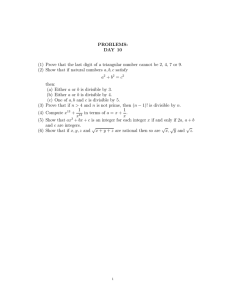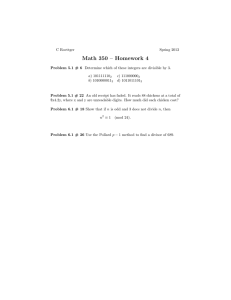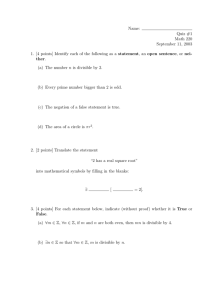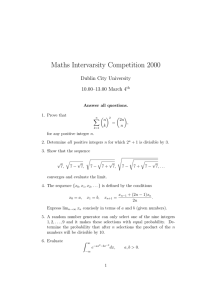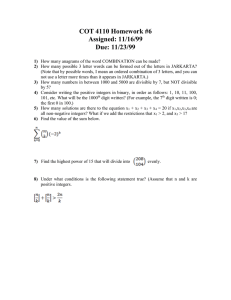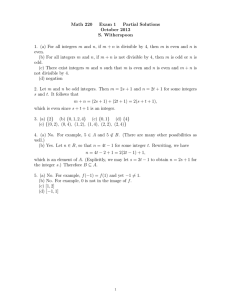MO-ARML – 1/27/07 Solutions to Individual Questions
advertisement
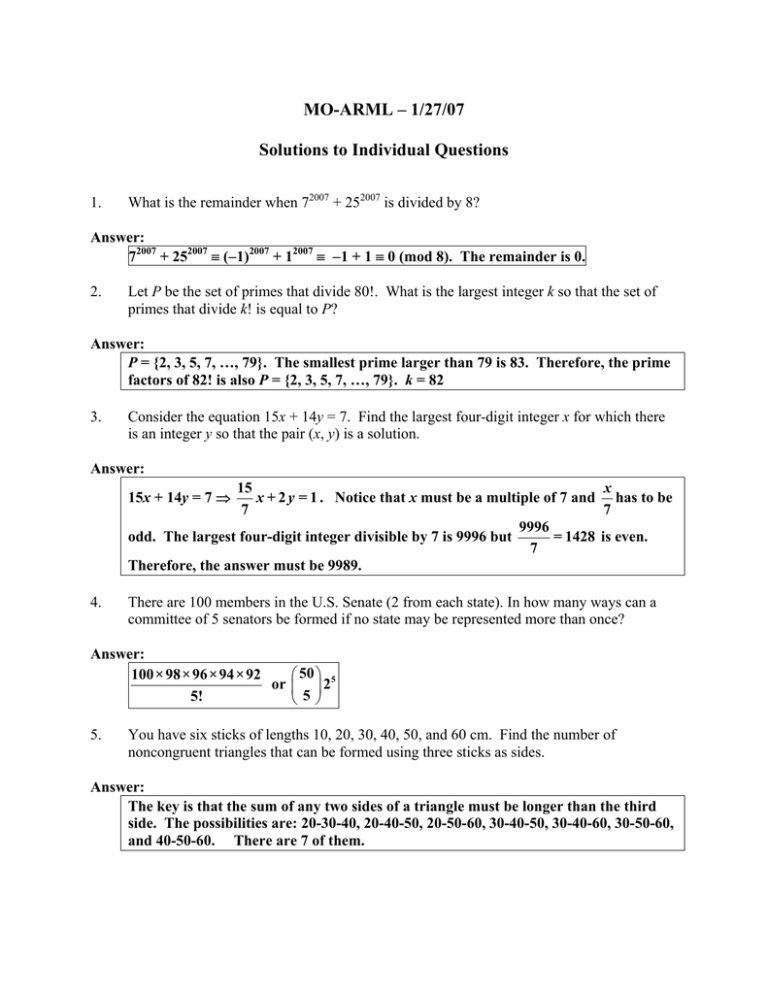
MO-ARML – 1/27/07
Solutions to Individual Questions
1.
What is the remainder when 72007 + 252007 is divided by 8?
Answer:
72007 + 252007 ≡ (−1)2007 + 12007 ≡ −1 + 1 ≡ 0 (mod 8). The remainder is 0.
2.
Let P be the set of primes that divide 80!. What is the largest integer k so that the set of
primes that divide k! is equal to P?
Answer:
P = {2, 3, 5, 7, …, 79}. The smallest prime larger than 79 is 83. Therefore, the prime
factors of 82! is also P = {2, 3, 5, 7, …, 79}. k = 82
3.
Consider the equation 15x + 14y = 7. Find the largest four-digit integer x for which there
is an integer y so that the pair (x, y) is a solution.
Answer:
x
15
x + 2 y = 1 . Notice that x must be a multiple of 7 and has to be
7
7
9996
odd. The largest four-digit integer divisible by 7 is 9996 but
= 1428 is even.
7
Therefore, the answer must be 9989.
15x + 14y = 7 ⇒
4.
There are 100 members in the U.S. Senate (2 from each state). In how many ways can a
committee of 5 senators be formed if no state may be represented more than once?
Answer:
50
100× 98× 96× 94× 92
or 25
5!
5
5.
You have six sticks of lengths 10, 20, 30, 40, 50, and 60 cm. Find the number of
noncongruent triangles that can be formed using three sticks as sides.
Answer:
The key is that the sum of any two sides of a triangle must be longer than the third
side. The possibilities are: 20-30-40, 20-40-50, 20-50-60, 30-40-50, 30-40-60, 30-50-60,
and 40-50-60. There are 7 of them.
6.
19 x − 8
A
C
and
is decomposed into partial fractions
(that sum to the
2
2 x − x − 21
ax + b
cx + d
given factor), what is the sum of the numerators when each fraction is reduced to lowest
terms?
When
Answer:
19 x - 8
19 x − 8
A
C
=
=
+
, then 19x – 8 = A(x + 3) + C(2x – 7).
2
2 x − x − 21 (2 x − 7)( x + 3) 2 x − 7 x + 3
x = –3 ⇒ –65 = –13C ⇒ C = 5; x = 7/2 ⇒ 117/2 = (13/2)A ⇒ A = 9. The sum is
therefore 14.
A
If
7.
A pentagon made up of equilateral triangle ABC
with side length 2 on top of square BCDE is
inside a circle passing through points A, D, and E.
Find the radius of the circle.
C
B
O
F
Answer:
E
D
JJJG
Intuitively, if O is the center of the circle, then the ray AO intersects the segment ED
at F, then AF ⊥ ED and the quadrilateral ABEO is a parallelogram. Therefore, the
radius is equal to EO = AB = 2.
8.
Consider the set T of positive integers d for which there exists an integer n such that d
evenly divides both 13n + 6 and 12n + 5. Find the sum of the elements of T.
Answer:
If d divides both 13n + 6 and 12n + 5, then d divides (13n + 6) – (12n + 5) = n + 1.
Then, d divides 13(n + 1) = (13n + 6) + 7, which means that d divides 7 ⇒ d = 1, 7.
d = 1 obviously works, since 1 divides anything. d = 7 is also acceptable by using
n = 13. The sum is 8.
9.
Among all collections, S, of positive integers whose sum is 28, what is the largest product
that the integers in S can form?
Answer:
If a ≥ 4, then a = (a – 2) + 2 and 2(a – 2) – a = a – 4 ≥ 0. Therefore, we should use only
2’s and 3’s as summands of 28 in order to achieve the largest product. Also, since
2 + 2 + 2 = 3 + 3 but 2⋅2⋅2 < 3⋅3, we shouldn’t use more than two 2’s, leaving
28 = 9(3) + 1 = 8(3) + 2(2) as the two only options. The largest product will be
achieved when 28 = 8(3) + 2(2), yielding 3822 = 26244.
10.
Find the number of four-digit positive integers divisible by either 3 or 7.
Answer:
10000 1000 10000 1000 10000 1000
3 − 3 + 7 − 7 - 21 − 21
= 3333 – 333 + 1428 – 142 – (476 – 47) = 3000 + 1286 – 429 = 3857
11.
How many possible values can there be for three coins selected from among pennies,
nickels dimes, and quarters?
Answer:
n + m − 1
There are
ways to select m objects out of n objects if repetition is allowed.
m
4 + 3 − 1 6 6× 5 × 4
= 20 ways.
(Three.xls)(Four.xls)
Thus, there are
= =
3 3 1× 2× 3
12.
What is the largest integer k such that n3 – n is divisible by k for all positive integers n?
Answer:
When n = 1, n3 – n = 0 doesn’t give us any information. When n = 2, n3 – n = 6
suggests k = 6. For more general n, n3 – n = n(n + 1)(n – 1) is the product of three
consecutive integers. Since one of them must be even, the product is divisible by 2.
Since one of them must be divisible by 3 as well, the product of any three consecutive
integers is divisible by 6.
13.
A triangle has vertex A at (0, 3), vertex B at (4, 0), and a vertex C at (x, 5) for some x
where 0 < x < 4. If the area of the triangle is 8, what is the value of x?
Answer:
The area of the triangle in the middle is the area of the
the area of the square minus the areas of the three
surrounding triangles.
8 = 20 – 6 – x – (5/2)(4 – x)
= 4 + (3/2)r
⇒ x = 8/3
14.
(x, 5)
(0, 3 )
(4 , 0)
There are two noncongruent rectangles with the integral sides for which the numerical area
equals the numerical perimeter (ignoring units). What is the sum of the areas of the two
rectangles?
Answer:
wl = 2(w + l) ⇒ wl – 2w – 2l = 0 ⇒ (w – 2)(l – 2) = 4. Since both w and l are integers,
w – 2 = l – 2 = 2 or w – 2 = 1, l – 2 = 4. The first area is 16 and the second area is 18,
and their sum is 34.
15.
The numbers from 1 to 2007 are listed in the following order: First of all, all numbers not
divisible by 3 are listed in increasing order; next, all numbers divisible by 3 but not by 32
are listed in increasing order; then, all numbers divisible by 32 but not by 33 are listed in
increasing order; and so on. What is the last number in the list?
Answer:
The powers of 3 are: 3, 9, 27, 81, 243, 729, 2187, therefore the last number must be a
multiple of 729 and less than 2007, which is 1458.
16.
A circle passing through two adjacent
vertices of a square and is tangent to the
opposite side of the square. If the side
length is 2, what is the radius of the circle?
r
r
O
2-r
r
Answer:
r2 = 12 + (2 – r)2
17.
⇒ 4r – 5 = 0
⇒ r = 5/4
What is the first time after 8:00 when the minute and hour hands form equal angles with
the vertical?
Answer:
At 8:00, the hour hand forms an angle of 60° with the vertical and the minute hand
forms a 0° with the vertical. As each minute passes, the hour hand moves (30/60)°,
while the minute hand moves 6°. If at x minutes after 8:00 the two angles are the
same, then 60 + x/2 = 6x, implying x = 120/11 = (≈ 10.8).
18.
Write a quadratic equation with leading coefficient of 1 having as its two roots the
numbers obtained by increasing each root of x2 – 2x – 5 = 0 by the reciprocal of the other.
Answer:
If the two roots of x2 – 2x – 5 are α and β, then αβ = –5. α + 1/β = α – α/5 = (4/5)α.
Similarly, β + 1/α = (4/5)β. The quadratic equation we are looking for can be
2
5
5
constructed as x − 2 x − 5 = 0 . In order to reduce the leading coefficient to
4
4
8
16
= 0.
1, we multiply by 16/25, producing x 2 − x −
5
5
19.
A regular polygon of n sides inscribed in a circle of radius r has area
nr 2
. What is the
4
value of n?
Answer:
The area of this polygon is equal to
n times of the area of the triangle
like the one given. Therefore,
1 2 360D nr 2
n ⋅ r sin
=
2
4
n
360D 1
360D
⇒
= 30°, 150°, …. ⇒ n = 12
sin
=
n
n
2
20.
ce nte r
r
r
si de
What is the largest number of 0s that can occur at the end of 1n + 2n + 3n + 4n for any
positive integer n?
Answer:
1 + 2 + 3 + 4 = 10; 1 + 4 + 9 + 16 = 30; 1 + 8 + 27 + 64 = 100; so we know at least two
0s may occur. In order for three 0s to occur, the sum has to be divisible by 8.
For all n, 1n ≡ 1 (mod 8); 2n ≡ 0 (mod 8) if n ≥ 3; 3n ≡ 3, 1 (mod 8);
4n ≡ 0 (mod 8) if n ≥ 2. Therefore, 1n + 2n + 3n + 4n ≡ 2 or 4 (mod 8), not divisible by 8.
21.
If 2f(x) + f(1 – x) = x2 for all x, then f(x) = ?
Answer:
Then, 2f(1 – x) + f(1 – (1 – x)) = (1 – x)2, r equivalently, 2f(1 – x) + f(x) = (1 – x)2.
Adding together, we have 3f(x) + 3f(1 – x) = x2 + (1 – x)2, or equivalently,
f(x) + f(1 – x) = [x2 + (1 – x)2]/3 ⇒ f(x) = x2 – [x2 + (1 – x)2]/3 = (x2 +2x – 1)/3
22.
How many ending zeros are there in the decimal representation of 2007!
Answer:
Each time a 5 can be factored out from an integer between 1 and 2007, it generates an
2007
= 401 multiples of 5 between 1 and 2007.
additional ending zero. There are
5
2007
2007
52 = 80 of these multiples are divisible by 25; 53 = 16 of these multiples are
2007
divisible by 125; 4 = 3 of them are divisible by 625. Altogether,
5
401 + 80 + 16 + 3 = 500 times a 5 can be factored out. Therefore, there are 500
ending zeros.

